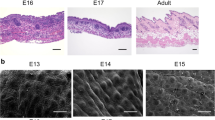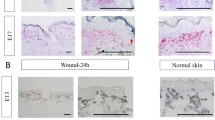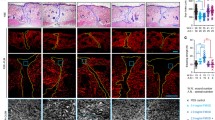Abstract
Up until late in the third trimester of gestation and through to adulthood, the healing response acts more to regenerate than to repair a wound. The mechanisms underlying this “scar-free” healing remain unknown although the actin cytoskeleton has a major role. Flightless I (Flii), an actin-remodelling protein and essential developmental regulator, negatively affects wound repair but its effect on scar-free fetal healing is unknown. Using fetal skin explants from E17 (regenerate) and E19 (repair) rats, the function of Flii in fetal wound repair was determined. Expression of Flii increased between E17 and E19 days of gestation and wounding transiently increased Flii expression in E17 but not E19 wounds. However, both confocal and immunofluorescent analysis showed E17 keratinocytes immediately adjacent to the wounds downregulated Flii. As a nuclear coactivator and inhibitor of proliferation and migration, the absence of Flii in cells at the edge of the wound could be instrumental in allowing these cells to proliferate and migrate into the wound deficit. In contrast, Flii was strongly expressed within the cytoplasm and nucleus of keratinocytes within epidermal cells at the leading edge of E19 wounded fetal skin explants. This increase in Flii expression in E19 wounds could affect the way these cells migrate into the wound space and contribute to impaired wound healing. Neutralising Flii protein improved healing of early- but not late-gestation wounds. Flii did not colocalise with actin cables formed around E17 wounds suggesting an independent mechanism of action distinct from its actin-binding function in scar-free wound repair.







Similar content being viewed by others
References
Adams DH, Strudwick XL, Kopecki Z, Hooper-Jones JA, Matthaei KI et al (2008) Gender specific effects on the actin-remodelling protein Flightless I and TGF-beta1 contribute to impaired wound healing in aged skin. Int J Biochem Cell Biol 40:1555–1569
Adams DH, Ruzehaji N, Strudwick XL, Greenwood JE, Campbell HD et al (2009) Attenuation of Flightless I, an actin-remodelling protein improves burn injury repair via modulation of TGF-1 and TGF-3. Br J Dermatol 161:326–336
Belford DA (1997) The mechanism of excisional fetal wound repair in vitro is responsive to growth factors. Endocrinology 138:3987–3996
Campbell HD, Fountain S, McLennan IS, Berven LA, Crouch MF et al (2002) Fliih, a gelsolin-related cytoskeletal regulator essential for early mammalian embryonic development. Mol Cell Biol 22:3518–3526
Claudianos C, Campbell HD (1995) The novel flightless-I gene brings together two gene families, actin-binding proteins related to gelsolin and leucine-rich-repeat proteins involved in Ras signal transduction. Mol Biol Evol 12:405–414
Cowin AJ (2005) Differential expression of F-actin in in utero fetal wounds. Eur J Dermatol 15:133–139
Cowin AJ, Brosnan MP, Holmes TM, Ferguson MW (1998) Endogenous inflammatory response to dermal wound healing in the fetal and adult mouse. Dev Dyn 212:385–393
Cowin AJ, Holmes TM, Brosnan P, Ferguson MW (2001) Expression of TGF-beta and its receptors in murine fetal and adult dermal wounds. Eur J Dermatol 11:424–431
Cowin AJ, Hatzirodos N, Teusner JT, Belford DA (2003) Differential effect of wounding on actin and its associated proteins, paxillin and gelsolin, in fetal skin explants. J Invest Dermatol 120:1118–1129
Cowin AJ, Adams DH, Strudwick XL, Chan H, Hooper JA et al (2007) Flightless I deficiency enhances wound repair by increasing cell migration and proliferation. J Pathol 211:572–581
Davy DA, Ball EE, Matthaei KI, Campbell HD, Crouch MF (2000) The flightless I protein localizes to actin-based structures during embryonic development. Immunol Cell Biol 78:423–429
Davy DA, Campbell HD, Fountain S, de Jong D, Crouch MF (2001) The flightless I protein colocalizes with actin- and microtubule-based structures in motile Swiss 3T3 fibroblasts: evidence for the involvement of PI 3-kinase and Ras-related small GTPases. J Cell Sci 114:549–562
Ferguson MW, O’Kane S (2004) Scar-free healing: from embryonic mechanisms to adult therapeutic intervention. Philos Trans R Soc Lond B Biol Sci 359:839–850
Fong KS, de Couet HG (1999) Novel proteins interacting with the leucine-rich repeat domain of human flightless-I identified by the yeast two-hybrid system. Genomics 58:146–157
Gangnuss S, Cowin AJ, Daehn IS, Hatzirodos N, Rothnagel JA et al (2004) Regulation of MAPK activation, AP-1 transcription factor expression and keratinocyte differentiation in wounded fetal skin. J Invest Dermatol 122:791–804
Goshima M, Kariya K, Yamawaki-Kataoka Y, Okada T, Shibatohge M et al (1999) Characterization of a novel Ras-binding protein Ce-FLI-1 comprising leucine-rich repeats and gelsolin-like domains. Biochem Biophys Res Commun 257:111–116
Hopkinson-Woolley J, Hughes D, Gordon S, Martin P (1994) Macrophage recruitment during limb development and wound healing in the embryonic and foetal mouse. J Cell Sci 107(Pt 5):1159–1167
Ihara S, Motobayashi Y (1992) Wound closure in foetal rat skin. Development 114:573–582
Ihara S, Motobayashi Y, Nagao E, Kistler A (1990) Ontogenetic transition of wound healing pattern in rat skin occurring at the fetal stage. Development 110:671–680
Jacinto A, Martinez-Arias A, Martin P (2001) Mechanisms of epithelial fusion and repair. Nat Cell Biol 3:E117–E123
Kopecki Z, Cowin AJ (2008) Flightless I: An actin-remodelling protein and an important negative regulator of wound repair. Int J Biochem Cell Biol 40:1415–1419
Kopecki Z, Arkell R, Powell BC, Cowin AJ (2009) Flightless I regulates hemidesmosome formation and integrin mediated cellular adhesion and migration during wound repair. J Invest Dermatol 129(8):2031–2045
Kwiatkowski DJ (1999) Functions of gelsolin: motility, signaling, apoptosis, cancer. Curr Opin Cell Biol 11:103–108
Lee YH, Stallcup MR (2006) Interplay of Fli-I and FLAP1 for regulation of beta-catenin dependent transcription. Nucleic Acids Res 34:5052–5059
Lee YH, Campbell HD, Stallcup MR (2004) Developmentally essential protein flightless I is a nuclear receptor coactivator with actin binding activity. Mol Cell Biol 24:2017–2103
Liu YT, Yin HL (1998) Identification of the binding partners for flightless I, a novel protein bridging the leucine-rich repeat and the gelsolin superfamilies. J Biol Chem 273:7920–7927
Longaker MT, Peled ZM, Chang J, Krummel TM (2001) Fetal wound healing: progress report and future directions. Surgery 130:785–787
Martin P (1997) Wound healing—aiming for perfect skin regeneration. Science 276:75–81
Martin P, Lewis J (1992) Actin cables and epidermal movement in embryonic wound healing. Nature 360:179–183
McCluskey J, Martin P (1995) Analysis of the tissue movements of embryonic wound healing—DiI studies in the limb bud stage mouse embryo. Dev Biol 170:102–114
McEwan PA, Scott PG, Bishop PN, Bella J (2006) Structural correlations in the family of small leucine-rich repeat proteins and proteoglycans. J Struct Biol 155:294–305
Mori R, Power KT, Wang CM, Martin P, Becker DL (2006) Acute downregulation of connexin43 at wound sites leads to a reduced inflammatory response, enhanced keratinocyte proliferation and wound fibroblast migration. J Cell Sci 119(Pt 24):5193–5203
Rudolph R, Vande Berg J, Erlich HP (1992) Wound contraction and scar contracture. In: Wound Healing Biochemical and Clinical Aspects. W.B. Saunders, Philadelphia
Seward ME, Easley CAt, McLeod JJ, Myers AL, Tombes RM (2008) Flightless-I, a gelsolin family member and transcriptional regulator, preferentially binds directly to activated cytosolic CaMK-II. FEBS Lett 582:2489–2495
Stelnicki EJ, Chin GS, Gittes GK, Longaker MT (1999) Fetal wound repair: where do we go from here? Semin Pediatr Surg 8:124–130
Straub KL, Stella MC, Leptin M (1996) The gelsolin-related flightless I protein is required for actin distribution during cellularisation in Drosophila. J Cell Sci 109(Pt 1):263–270
Sun HQ, Yamamoto M, Mejillano M, Yin HL (1999) Gelsolin, a multifunctional actin regulatory protein. J Biol Chem 274:33179–33182
Xu X, Francis R, Wei CJ, Linask KL, Lo CW (2006) Connexin 43-mediated modulation of polarized cell movement and the directional migration of cardiac neural crest cells. Development 133:3629–3639
Zheng B, Han M, Bernier M, Wen JK (2009) Nuclear actin and actin-binding proteins in the regulation of transcription and gene expression. FEBS J 276:2669–2685
Acknowledgments
This work was supported by grants from the National Health and Medical Research Council of Australia and the Women’s and Children’s Hospital Research Foundation. AJC is supported by an NHMRC Senior Research Fellowship. RA is supported by The Sylvia and Charles Viertel Charitable Foundation.
Author information
Authors and Affiliations
Corresponding author
Rights and permissions
About this article
Cite this article
Lin, CH., Waters, J.M., Powell, B.C. et al. Decreased expression of Flightless I, a gelsolin family member and developmental regulator, in early-gestation fetal wounds improves healing. Mamm Genome 22, 341–352 (2011). https://doi.org/10.1007/s00335-011-9320-z
Received:
Accepted:
Published:
Issue Date:
DOI: https://doi.org/10.1007/s00335-011-9320-z




